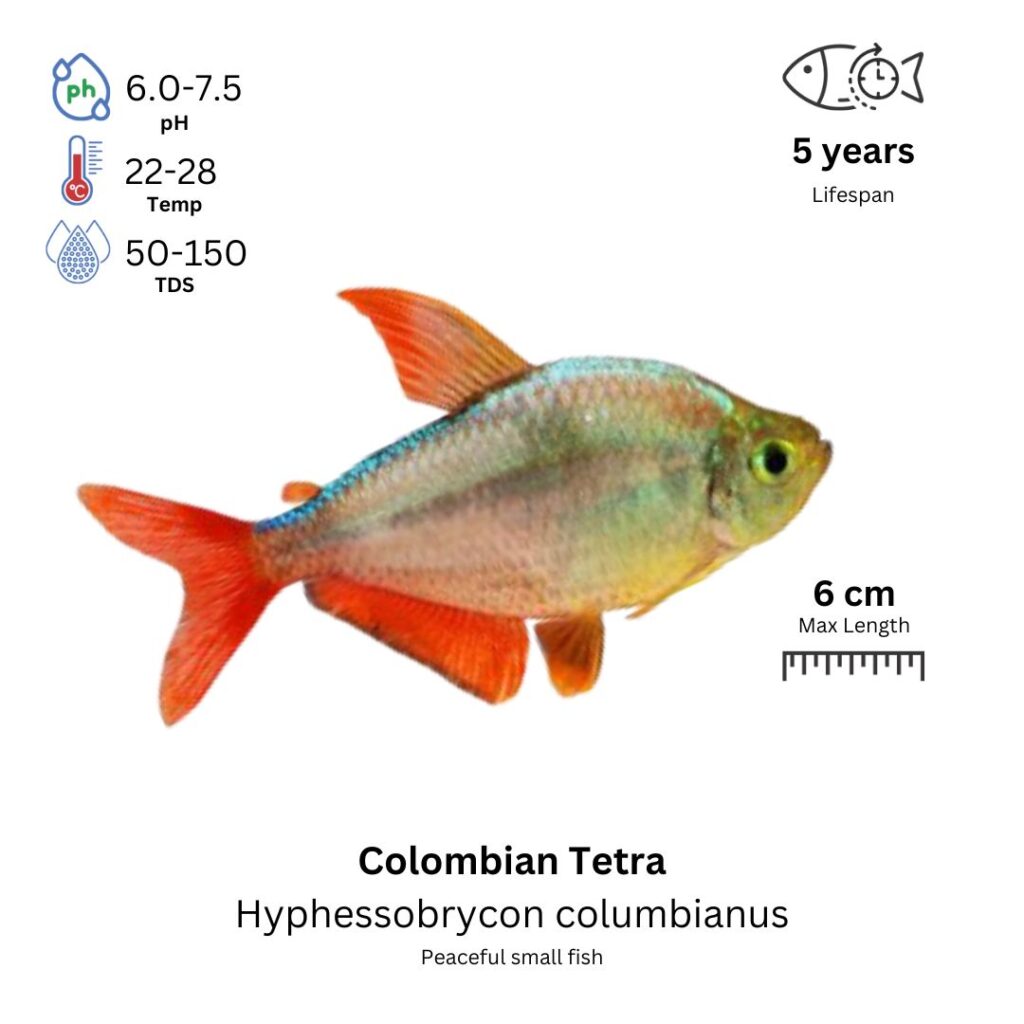Colombian Tetra
Hyphessobrycon columbianus

Description
The Colombian Tetra is a beautiful, medium-sized tetra known for its stunning coloration. It has a silvery body with a unique iridescent blue and yellow-green sheen, especially around the edges of its fins and the body. The body itself is typically a translucent silvery color with a noticeable black stripe running from the head to the tail, giving it a dramatic appearance. Colombian Tetras have a streamlined, slightly elongated body with a forked tail. Males are generally smaller and more colorful than females. These fish are peaceful, active, and social, making them ideal for community tanks. Their vibrant colors and schooling behavior make them stand out in any aquarium.
Habitat Origin
Native to the fast-moving rivers of Colombia and Venezuela in South America, specifically in the upper Orinoco and Magdalena River basins. These fish are typically found in clear, moderately acidic waters with moderate flow, often among submerged rocks and dense vegetation. Colombian Tetras are accustomed to well-oxygenated water and thrive in stable, clean environments.
Aquarium
Ideal Number in Aquarium: At least 6 individuals, as they are schooling fish and feel more secure in groups.
Favorite Food

Colombian Tetras are omnivores and will accept a variety of foods, including high-quality flake food, micro pellets, and live or frozen foods such as brine shrimp, daphnia, and bloodworms. They will also graze on small algae and plant matter. A varied diet ensures they maintain their vibrant colors and active behavior, contributing to their overall health.
Behavior:
Colombian Tetras are peaceful, active fish that thrive in groups. They are lively swimmers and spend most of their time in the middle and upper regions of the tank. These tetras are social and do best when kept in schools, where they feel secure and display their natural behaviors and vibrant colors. They are not aggressive but may be a bit shy when kept alone or in small groups. Colombian Tetras are generally calm and can coexist with a wide range of peaceful fish species in community tanks.
Special Care:
Colombian Tetras require stable water conditions, and they are sensitive to poor water quality. They thrive in clean, well-maintained aquariums with regular water changes and good filtration. These fish prefer slightly acidic to neutral water and enjoy moderate water flow. Providing them with a well-planted tank with plenty of hiding spots will help reduce stress, especially if they are kept with other species. Since they are used to fast-moving waters in the wild, a gentle filter providing moderate flow is ideal.
Compatibility with Other Fish:
Yes, Colombian Tetras are compatible with other peaceful species, such as small tetras, rasboras, small catfish, and peaceful shrimp. They do well in community tanks with other non-aggressive species, but they may become stressed or shy if housed with large, aggressive fish. Their schooling nature and calm temperament make them perfect for peaceful, multi-species tanks.
Breeding Setup
Setting up a separate breeding tank is recommended for Colombian Tetras to control water conditions and prevent adult fish from eating the eggs. A 40-liter (10-gallon) tank is suitable, providing enough room for breeding activity and fry development. Ideal water conditions include a pH of 6.0–7.5, temperature of 24–28°C (75–82°F), and hardness between 4–12 dGH. Use a gentle sponge or internal filter to maintain water quality without strong currents. Incorporate fine sand or gravel, live plants like Java moss or Hornwort, and floating plants to simulate a shaded, natural environment. Moderate lighting is preferred to avoid stress.
Conditioning for Breeding
To condition Colombian Tetras for breeding, provide a high-protein, varied diet. Offer live foods (such as brine shrimp, daphnia, bloodworms), frozen foods (like mysis shrimp), and quality flake foods. A nutritious diet supports egg development and increases spawning success. Perform weekly 25% water changes to maintain a healthy environment and encourage breeding behavior through stable, clean water.
Spawning Process
Spawning typically takes place early in the morning or evening. Males will display intense coloration and chase females as part of their courtship behavior. Females lay 50–100 sticky eggs, which adhere to plants, tank walls, or decorations. After spawning, it is crucial to remove the adult fish to prevent them from eating the eggs, which is a common issue with this species.
Fry Care
The eggs hatch within 24–48 hours, depending on water temperature. Fry initially remain attached to surfaces, feeding off their yolk sacs. Once they are free-swimming, feed them infusoria or liquid fry food, then gradually introduce baby brine shrimp or other micro live foods. As they grow, you can begin offering finely crushed flake food. Maintain high water quality with daily 10–15% water changes, and ensure ammonia and nitrite levels stay near zero to support healthy fry development.
Important Notes
Colombian Tetras reach sexual maturity between 6–12 months. Males are smaller and more colorful, while females are larger and rounder, especially when gravid. To avoid stress and maximize breeding success, ensure stable tank conditions, peaceful surroundings, and avoid overcrowding or aggressive tankmates. A calm environment with consistent water parameters is key to successful spawning and fry survival.
